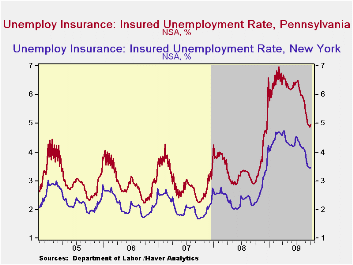 Global| Oct 29 2009
Global| Oct 29 2009U.S. Weekly Initial Claims For Unemployment Insurance Hold Steady
by:Tom Moeller
|in:Economy in Brief
Summary
The trend toward improvement in the job market continued this month. The Labor Department indicated that initial claims for unemployment insurance held roughly steady w/w at 530,000. The figures are down moderately from an average of [...]
 The trend
toward improvement in the job market continued this month. The Labor
Department indicated that initial claims for unemployment insurance
held roughly steady w/w at 530,000. The figures are down moderately
from an average of 549,000 claims during September and are down sharply
from the peak reached in March of 674,000 claims. The four-week moving
average of claims fell to 526,250 while the latest weekly figure was
slightly higher than Consensus expectations for 521,000 claims.
The trend
toward improvement in the job market continued this month. The Labor
Department indicated that initial claims for unemployment insurance
held roughly steady w/w at 530,000. The figures are down moderately
from an average of 549,000 claims during September and are down sharply
from the peak reached in March of 674,000 claims. The four-week moving
average of claims fell to 526,250 while the latest weekly figure was
slightly higher than Consensus expectations for 521,000 claims.
The largest increases in initial claims during the week ending October 17 were in California (+5,774, +12.6% y/y), Puerto Rico (+685, +52.9% y/y), Minnesota (+614, +38.8% y/y), Nevada (+366, 8.7% y/y ), and Nebraska (+239, -1.6% y/y), while the largest decreases were in Wisconsin (-5,681, +29.5%), New York (-4,711, +15.5% y/y), Pennsylvania (-4,033, +28.2% y/y), Illinois (-3,870, +44.9% y/y), and Oregon (-2,706, -16.6% y/y).
Continuing claims for unemployment insurance
during the latest week fell 148,000 to their lowest level since
late-March.  The decline reflects the improved job market but may also
be a function of the exhaustion of benefits. Continuing claims provide
an indication of workers' ability to find employment. The four-week
average of continuing claims fell modestly to 5,960,750 and have fallen
12.0% from their peak. This series dates back to
1966.
The decline reflects the improved job market but may also
be a function of the exhaustion of benefits. Continuing claims provide
an indication of workers' ability to find employment. The four-week
average of continuing claims fell modestly to 5,960,750 and have fallen
12.0% from their peak. This series dates back to
1966.
Extended benefits for unemployment insurance fell slightly for the first decline in seven weeks. The prior week's level was revised up. Through early-October extended benefits averaged 551,381.
The insured rate of unemployment slipped again to 4.4%, from an unrevised 4.5%, and matched its lowest since late-March. The rate reached a high of 5.2% during late-June. During the last ten years, there has been a 93% correlation between the level of the insured unemployment rate and the overall rate of unemployment published by the Bureau of Labor Statistics.
 The lowest insured unemployment
rates during the week ending October 9 were in North Dakota (1.1%),
South Dakota (1.1), Virginia (2.0), Wyoming (2.4), Maine (2.4), Texas
(2.6), Colorado (2.9), Minnesota (3.0), Maryland (3.1), Mississippi
(3.5), New York (3.5), Florida (3.7), and Georgia (3.8). The highest
insured unemployment rates were in Puerto Rico (6.3), Oregon (5.3),
Nevada (5.3), Pennsylvania (5.0), California (4.6), Michigan (4.6),
Wisconsin (4.8), North Carolina (4.5), South Carolina (4.5), and
Washington (4.3).
The lowest insured unemployment
rates during the week ending October 9 were in North Dakota (1.1%),
South Dakota (1.1), Virginia (2.0), Wyoming (2.4), Maine (2.4), Texas
(2.6), Colorado (2.9), Minnesota (3.0), Maryland (3.1), Mississippi
(3.5), New York (3.5), Florida (3.7), and Georgia (3.8). The highest
insured unemployment rates were in Puerto Rico (6.3), Oregon (5.3),
Nevada (5.3), Pennsylvania (5.0), California (4.6), Michigan (4.6),
Wisconsin (4.8), North Carolina (4.5), South Carolina (4.5), and
Washington (4.3).
The unemployment insurance claims data is available in Haver's WEEKLY database and the state data is in the REGIONW database.
Birth date, business cycles, and lifetime income from the U.S. Office of Management and Budget is available here.
| Unemployment Insurance (000s) | 10/23/09 | 10/16/09 | 10/09/09 | Y/Y | 2008 | 2007 | 2006 |
|---|---|---|---|---|---|---|---|
| Initial Claims | 530 | 531 | 520 | 9.3% | 420 | 321 | 313 |
| Continuing Claims | -- | 5,797 | 5,945 | 53.6% | 3,342 | 2,552 | 2,459 |
| Insured Unemployment Rate (%) | -- | 4.4 | 4.5 | 2.8 (10/2008) | 2.5 | 1.9 | 1.9 |
Tom Moeller
AuthorMore in Author Profile »Prior to joining Haver Analytics in 2000, Mr. Moeller worked as the Economist at Chancellor Capital Management from 1985 to 1999. There, he developed comprehensive economic forecasts and interpreted economic data for equity and fixed income portfolio managers. Also at Chancellor, Mr. Moeller worked as an equity analyst and was responsible for researching and rating companies in the economically sensitive automobile and housing industries for investment in Chancellor’s equity portfolio. Prior to joining Chancellor, Mr. Moeller was an Economist at Citibank from 1979 to 1984. He also analyzed pricing behavior in the metals industry for the Council on Wage and Price Stability in Washington, D.C. In 1999, Mr. Moeller received the award for most accurate forecast from the Forecasters' Club of New York. From 1990 to 1992 he was President of the New York Association for Business Economists. Mr. Moeller earned an M.B.A. in Finance from Fordham University, where he graduated in 1987. He holds a Bachelor of Arts in Economics from George Washington University.






